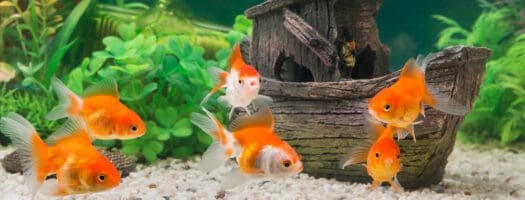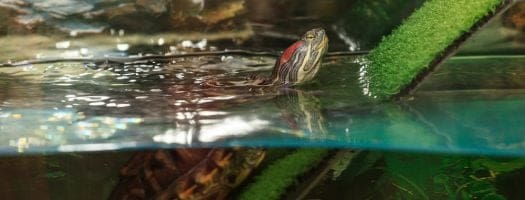The 10 Best Aquarium Air Stones to Buy in 2026
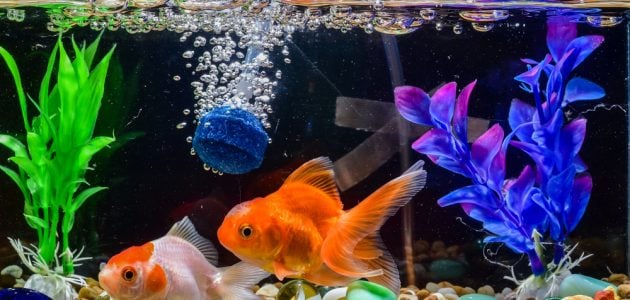
A smooth stream of bubbles will improve the look of any aquarium, no matter the shape or size. As far as we’re concerned, that’s simply a fact. Unfortunately, it’s not just beginners who are late to the bubble show. There are still seasoned hobbyists out there who don’t use aquarium air stones, and they’re missing out.
After all, a mesmerizing bubble flow isn’t the only thing air stones offer – they’re also excellent for aerating water, improving circulation, and fixing dead spots. So the more bubbles the better, right? Not so fast.
While an epic bubble flow will help showcase your setup for Instagram (#aquascaping), you can certainly have too much of a good thing. A bubble-filled aquarium may sound dreamy, but dealing with salt stains is a nightmare, and skittish fish will freak out.
Balance is key here – you can’t just submerge any old air stone under the water line and hope for the best. Pump power, tank size, and your aquarium’s bioload must all be considered. Still, air stones are the best way to add oxygen (along with a little flair) to your aquarium. Here’s everything you need to know.
- Factors to Consider When Choosing Aquarium Air Stones
- Top 10 Best Aquarium Air Stones 2026
- 1. Best Overall Aquarium Air Stones: Pawfly All-in-One Air Pump Accessory Kit
- 2. Best Budget Aquarium Air Stones: Yueton Cylinder Aquarium Air Stones
- 3. Best for Hydroponics & Planted Aquariums: VIVOSUN Air Stone
- 4. Best Premium Aquarium Air Stones: Hygger Aquarium Air Stone Kit
- 5. Best Ornamental Air Stone: TEEMO Groot Air Bubbler
- 6. Smallest Aquarium Air Stones: Pawfly 1 Inch Air Stone
- 7. Best Jetting Volume Air Stone: Pawfly 4 Inch Air Stone
- 8. Best Multi-Tank Air Stones: Wenshall 1.6" Small Round Air Stones
- 9. Best LED Air Stone: NICREW Multi-Colored LED Air Stone Disk
- 10. Best Novelty Air Stone: NICREW Aquarium Volcano
- Guide to Buying the Best Aquarium Air Stones
- Are Your Fish Getting Enough Air?
- How Aquarium Air Stones Work
- Do You Need an Air Stone?
- Benefits of Aquarium Air Stones
- Picking the Best Air Stone for Your Aquarium
- Equipment You Need to Get Started
- How to Set up an Aquarium Air Stone
- Where to Place Air Stones in Your Aquarium
- How to Clean & Maintain Your Aquarium Air Stones
- Frequently Asked Questions
- A Health Investment for Your Aquarium
Factors to Consider When Choosing Aquarium Air Stones
Is a disk-shaped stone better than a cylindrical one? What’s the difference between an air stone and a bubbler? How about a bubble wand? It can all get pretty confusing.
The good news is that we’ve done the hard work for you, rounding up the best of the bunch and making sure to include something for everyone – whether you’re a seasoned aquarist looking to splash the cash or a complete first-timer who’s buying on a budget.
Think of the below factors as a handy checklist for assessing air stones that take your fancy. In fact, these same factors were used as base criteria when evaluating for our top 10 product reviews.
Included Equipment
To run an air stone you need several different pieces of gear. Along with the stone itself, you’ll also have to get your hands on an air pump, airline tubing, and a control valve. There are also optional extras to think about, like suction cups, check valves, and tube splitters.
To learn more about what you need to start bubbling, check out our section on the required equipment for air stones.In any case, our reviews include the best singular air stones, multi-packs, air stones with tubing included, and all-in-one kits. You will need to buy the air pump separately, though. If you don’t have one already, we recommend the Tetra Whisper.
Size
Air stones typically fall between 1-6″ in size and you should take stock of your tank space before you hit that buy button. Overcrowding your tank with a stone that’s too large will disturb your fish. Too small and you’ll do little to improve the water quality. If you already own an air pump, take note of the tubing size it needs – it’s no good buying a stone because it includes tubing if it doesn’t fit your pump! We note the tubing size in all our reviews.
Air Pump Requirements
Every air stone comes with a suggested pump power wattage. Using a 4W capable stone with a 1.5W pump is a sure-fire way to end up disappointed. If you notice that your air stone isn’t producing bubbles across the full breadth of its porous surface, this is usually why.
Style
There’s a lot of variety here but ultimately it comes down to your visual preference. Don’t be confused by alternate terms like diffusers, bubblers, bubble wands/walls, or bubbler ornaments. While each looks slightly different, they all do the same thing. Our review list contains a range of different types, but for simplicity’s sake, we always use the term air stone.
Bubbles & Jetting Volume
Each air stone provides a slightly different flow speed and bubble size. Generally, you’re looking for a high quantity of small, fine bubbles. The finer the bubbles the better they look, and the quieter they’ll be when they break the surface. Notably, jetting volume (i.e., the flow rate per minute) isn’t always specified by the manufacturer. Our reviews always state the jetting volume when it’s given, and give indications as to expected performance when it’s not.
Materials & Durability
Air stones are usually made from a permeable, porous ceramic stone material. They’re also relatively cheap – it’s not uncommon to find a pack of 10 for around $10. So as you might expect, they don’t last forever. We find there’s significant variability in the quality of materials used and this is something you should factor into your pricing considerations. Fear not, we’ve highlighted our favorite premium and budget picks, and always specify the durability for each product we reviewed.
Of course, the specific factors you should prioritize in an air stone will depend on your experience level, the number of aquariums you own, the size of your tank(s), and whether or not you’re dealing with aquatic plants.
For a more detailed breakdown, you can head straight over to our guide on choosing the best aquarium air stones for your setup. Otherwise, with these factors in mind, let’s jump right into our top 10 picks.
Top 10 Best Aquarium Air Stones 2026
1. Best Overall Aquarium Air Stones: Pawfly All-in-One Air Pump Accessory Kit
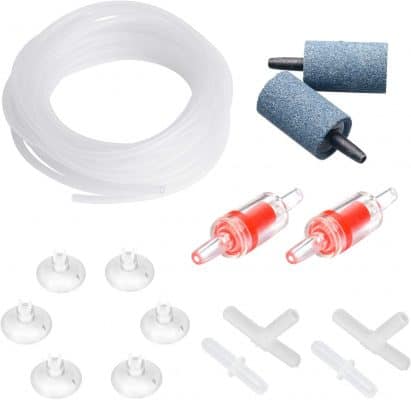
Editor’s Rating:
Why we like it: This all-in-one kit provides a complete solution for aquarists looking to introduce bubbles into their aquarium with minimal effort, and without breaking the bank.
Quick Facts
- Size(s): 1.2” x 0.8”
- Fits internal tubing diameter of: 3⁄16″
- Recommended air pump power: 2-4W
- Jetting volume: not specified
- Includes: 2 air stones, 7ft or 13ft tubing, 6 suction cups, 2 check valves, 2 straight connectors, and 2 T-shape connectors
Sizing & Power
The 2-4W power range covers the vast majority of ‘standard’ air pumps, making this kit suitable for those who already own a pump. Plus, the useful inclusion of T-shape connectors allows you to split the input and use a single pump to operate multiple air stones at once – perfect for those with large tanks, and multi-tank hobbyists. Most air stones don’t come with any tubing or split connectors, putting this product ahead of the competition, with full marks for versatility.
Style & Bubble Effect
This isn’t just an air stone, it’s a complete air pump accessory kit, and aside from the pump itself, it includes everything you need to get started, and at an impressively low cost. The air stones themselves are small and unobtrusive, producing a fine stream of bubbles that’s ideal for smaller aquariums.
Materials & Durability
As it’s a kit, you can be sure that the tubing and connectors will attach perfectly to the stones. This greatly reduces your chance of leaks and loose connections, which is a common problem with DIY setups.
It also makes the ease of setup unrivaled, and this is by far the most beginner-friendly product to make our list. The check valves prevent reverse water flow in the case of a power outage- so their inclusion in this kit is a nice bonus, too. Unfortunately, they do appear more cheaply made than the other components and may fault over time.
The air stones themselves are high quality though. Two are included, which is perfect for getting things up and running, but they won’t last forever. No problem – you can buy a 10x pack of replacement air stones without the additional accessories, and for a remarkably cheap price.
Pros
- Complete all-in-one solution (with connectors, suction cups, etc)
- Easy setup for beginners
- Choice in tubing size (7ft and 13ft)
- Cheap price
Cons
- Check valves prone to fault
2. Best Budget Aquarium Air Stones: Yueton Cylinder Aquarium Air Stones
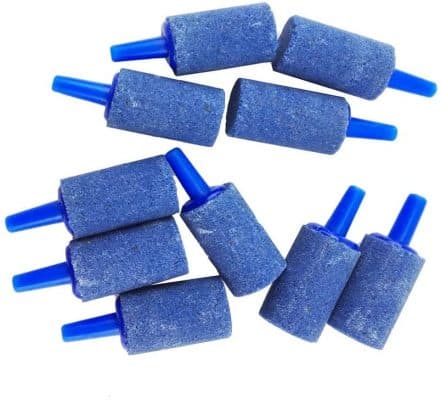
Editor’s Rating:
Why we like it: 10 well-made air stones at less than $1 each makes Yueton Cylinder's a no-brainer for our best budget pick.
Quick Facts
- Size(s): 1.57” x 0.59”
- Fits internal tubing diameter of: ⅛”
- Pump power required: not specified (we recommended 2-4W)
- Jetting volume: not specified (average)
- Includes: 10 air stones
Sizing & Power
The small cylinder shape of these air stones means they don’t awkwardly stick out (even in smaller setups) and your eyes are naturally drawn to the bubble effect rather than the stones. That said, the stones are slightly larger than in the Pawfly All-in-One Kit, which helps them to provide a stronger bubble flow.
There’s no official pump power requirement, but we suggest a 2-4W range. Less than 2W and the air stones won’t produce bubbles to their full potential, if your air pump is >4W these stones simply aren’t large enough to keep up.
Style & Bubble Effect
These cylindrical air stones will float unless nestled in the substrate or affixed with suction cups, but as they’re small we find this isn’t much of a problem. Plus, the bubble rate is unlikely to disturb even shy fish – as long as you don’t place the stone in their favorite hiding place!
We also love their deep blue color, it sets them apart from the traditional softer grey tones of the VIVOSUN Air Stone or the Pawfly 1 Inch, and the color blends very well once submerged.
Materials & Durability
Despite their plastic connector, we actually find these little stones to be incredibly durable. Although it’s not unheard of to find an occasional dud stone in the pack, but as each lasts so long, this shouldn’t be a deal-breaker for the impressive price.
Pros
- Large pack size (10)
- Well sized for smaller aquariums
- Strong blue finish blends well inside aquarium
- Low price point
Cons
- Occasional dud stones
3. Best for Hydroponics & Planted Aquariums: VIVOSUN Air Stone
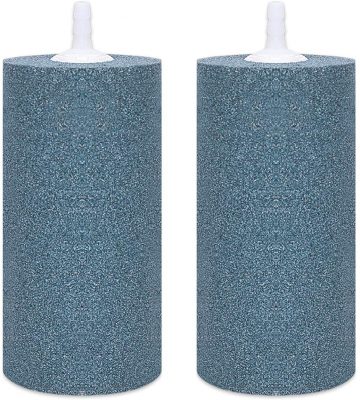
Editor’s Rating:
Why we like it: The VIVOSUN produces an incredible bubble flow, sufficient to aerate water in larger aquariums, planted tanks, and even complex hydroponic systems.
Quick Facts
- Size(s): 4” x 2”
- Fits internal tubing diameter of: ⅛”
- Pump power required: 4-8W
- Jetting volume: 2.5L/min
- Includes: 2 air stones
Sizing & Power
The aeration provided goes beyond the requirements of a standard aquarium, as they’re specifically designed for hydroponic systems, ponds, and planted aquariums.
While the 4″ length may not seem particularly large, it’s more than double the size of air stones like the Yueton, and as such it requires double the pump power, too. This makes a huge difference to the bubble rate, and the VIVOSUN is likely too much for tanks under 15 gallons. But for larger setups, these stones are truly excellent.
Positively, the weight of these air stones means they’ll stay grounded in your tank without further support, and we find this much easier than attaching/detaching suction cups when the stones need cleaning.
Style & Bubble Effect
It’s a large cylindrical shape that provides powerful water aeration. For those with planted aquariums or hydroponic systems, the strong circulation will also help you extend the life of your nutrient solutions – an indirect saving that’s worth factoring into your pricing considerations. Notably, while the VIVOSUN produces very fine bubbles, the rapid production rate could be disturbing to skittish fish.
PRO-TIP: frequently adding plant nutrition to your aquarium will significantly increase the incidence of air stone clogging. Don’t worry, this is normal and easily rectifiable. We advise fortnightly checks to spot when bubble production starts to drop off. When it does, follow our how to clean and maintain your aquarium air stones guide.
Materials & Durability
We like that this air stone’s connector tip is finished with an epoxy resin glue. Epoxy resin is completely inert to aquatic life and provides a more durable finish than cheap plastic. Expect these to last for several years if properly maintained – outstanding performance for air stone longevity.
Pros
- Suitable for use in ponds, hydroponic systems, and planted aquarium tanks
- Strong bubble production capable of circulating essential nutrients
- Stays grounded in the aquarium
- Connector tip finished with epoxy resin glue
Cons
- Requires a high-powered air pump
- Too disruptive for small tanks
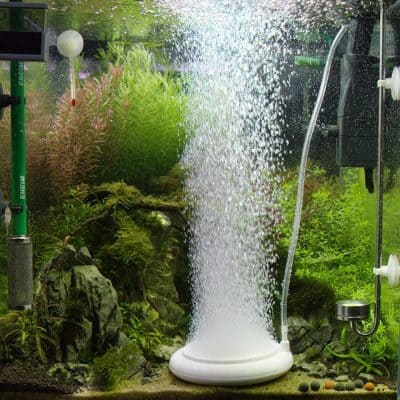
Editor’s Rating:
Why we like it: As well as the inclusion of an array of accessories, this product also offers choices in both size and color - perfect for those who don't mind paying a premium.
Quick Facts
- Size(s): small (2” diameter) or large (4” diameter)
- Fits internal tubing diameter of: ⅛” for 2″ size, ¼” for 4″ size
- Pump power required: 2W+ for small disk, 4W+ for large disk
- Jetting volume: 3L/min
- Includes: 1 air stone, 1 control valve, 1 check valve, 2 suction cups, 1 T-connector, 1 reducer
Sizing & Power
These Hygger disks are one of only two air stones to offer a color choice – the other being the Pawfly 1 Inch. This allows you to better match the disk with your substrate color, creating a more natural-looking tank that keeps your fish, or live plants, as the deserved focal point.
The choice of disk size also means a choice of power, but whichever you opt for – you’ll need to connect the stone to its own pump. You can’t share multiple stones with another airline as with the Pawfly All-in-One Kit or the Wenshall 1.6″.
If multiple air stones are a necessity in your case (as you have a large, or multiple tanks) you’ll need to decide whether the benefits of the Hygger are worth purchasing an additional pump.
Style & Bubble Effect
The air stone itself is a sleek disk shape, with a weighted base. As such the stone sinks naturally and doesn’t require any suction cups, although they’re still included. We like the flat disk-shaped design too, as it makes it unlikely to be knocked over by darting fish, which can be a problem with the TEEMO Groot Air Bubbler.
The output is a strong, rapid bubble stream that will help prevent debris stagnation more effectively than every other stone. This dense bubble production means you’ll need to clean your air stones more frequently – so consider whether you’re willing to add further time to your weekly maintenance.
One unique feature is the inclusion of a handy control valve, allowing you to control the level of bubble diffusion. Such features are reflected in the premium price tag; it’s the most expensive item to make our list.
Materials & Durability
While we prefer the disk design of the Hygger, the inclusion of (essential) air tubes makes the Pawfly All-in-One kit a more complete offering for 2W air pumps. Still, for larger tanks or those with a 4W+ air pump, there’s no other accessory kit that can compete with the Hygger 4″.
Finally, the airline intake attaches at an almost vertical angle. This is preferable when compared to a horizontal intake, or even underside connections (like on the Nicrew Multi-Colored LED Disk), which rest with a slight bend. Over time, this bending can reduce airflow and affect the longevity of the tubing.
Pros
- Multiple color and size choices
- Clever design (flat disk shape and vertical intake connection)
- Rapid and dense bubble production
- Bubble control value allows you to dictate flow rate
Cons
- Premium price tag
- Requires frequent cleaning
5. Best Ornamental Air Stone: TEEMO Groot Air Bubbler

Editor’s Rating:
Why we like it: The cutest air stone we've seen, this character-themed Groot stone is perfect for aquarists who want a fun-looking and low-maintenance aquarium bubbler.
Quick Facts
- Size(s): 5.5” x 2.8”
- Fits internal tubing diameter of: not specified
- Pump power required: 1.5W+
- Jetting volume: not specified (low)
- Includes: 1 air stone built into resin character
Sizing & Power
This air stone requires a (minimum) pump power of only 1.5W, making it ideal for those with small air pumps and for use in <10-gallon nanotanks. There’s no maximum pump power indicated, but we find it’ll max out around 4W. The stone itself doesn’t have the surface area to increase water flow noticeably beyond this point.
Style & Bubble Effect
One of only two ornamental designs to make our top 10 list (the other being a Volcano design) this air stone comes built into a cute Marvel comics Groot character figure.
It’s perfect for younger aquarists, or any hobbyist who prefers a more casual and fun style to their setup. A small wave of bubbles flows from the top of Groot’s head, which looks adorable and will provide sufficient water agitation for most standard-sized tanks.
Materials & Durability
It’s hand-painted with PVC which gives Groot a sharp, polished finish, but you should expect this to slowly fade with constant submersion. It’s light, making it easily removable for cleaning, but if anything it’s a little too light.
In fact, it’s prone to be knocked over by active fish, and will be displaced from the substrate with even mild water flows (don’t place it near your filter). We would like to have seen some extra weight added to the base of the structure to prevent this.
PRO-TIP: If you’re in love with the Groot design but worried about it toppling over, a simple DIY fix is to use aquarium silicone to affix it to the tank floor. The trade-off here is that you won’t be able to remove it for cleaning. Longer term, it’s possible to remove aquarium silicone if you ever want to permanently switch out the ornament.
Pros
- Cute design
- Easy to clean if not affixed to tank
- Doesn't require much air pump power
Cons
- Paintwork fades with time
- Prone to being displaced by active fish
6. Smallest Aquarium Air Stones: Pawfly 1 Inch Air Stone
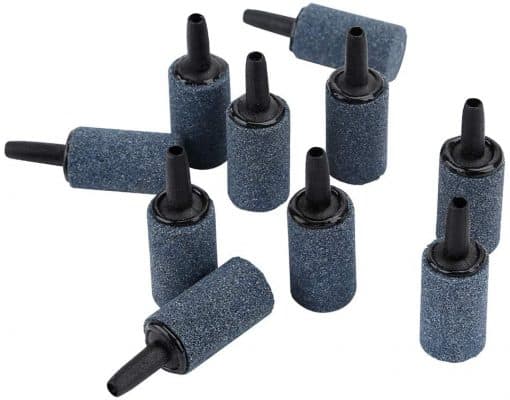
Editor’s Rating:
Why we like it: These bite-sized air stones are the best to add aeration to your aquarium without compromising on space.
Quick Facts
- Size(s): 1” x 0.6″
- Fits internal tubing diameter of: 3/16″
- Pump power required: 2-4W
- Jetting volume: 0.8L /min
- Includes: 10 grey or 12 blue air stones
Sizing & Power
If you’re struggling for space in a tank that’s pushing capacity, or simply want to avoid the eyesore of a large stone, these bite-sized cylinders should be your go-to.
The blue variation contains a whopping 12 air stones, making it the cheapest ‘cost-per-stone’ price we’ve seen and a close contender for our top budget pick. Ultimately, we still gave Yueton the nod, as for a similar price you get larger and slightly more robust stones.
Just remember that with the small size there’s an inevitable trade-off in output, with 0.8L/m being the maximum flow rate. By comparison, the Hygger Air Stone produces almost 4 times that.
Style & Bubble Effect
These tiny cylindrical stones won’t win any prizes for their aesthetics and you’ll need to secure them with suction cups to keep their position fixed. But when they’re in the tank, you’ll hardly notice them. Note that the bubble flow won’t be sufficient for aquariums that are reliant on increased oxygenation for tank health – such as those with heavily planted tanks, or tanks stocked close to their bioload capacity.
Materials & Durability
Like the VIVOSUN, these stones use epoxy resin on the connector tip surface, for improved durability. Plus, each stone arrives individually packed.
When kept out of water air stones are prone to crumbling with contact; this separate packaging is a great way to ensure they stay intact on their way to you. Still, you’ll need to replace them fairly frequently, but that’s not a big issue considering how many you get.
Pros
- Smallest air stone size available
- Good packaging design
- Low price point
Cons
- Need to be secured to the tank
- Output can't compete with larger air stones
- Need replacing often
7. Best Jetting Volume Air Stone: Pawfly 4 Inch Air Stone
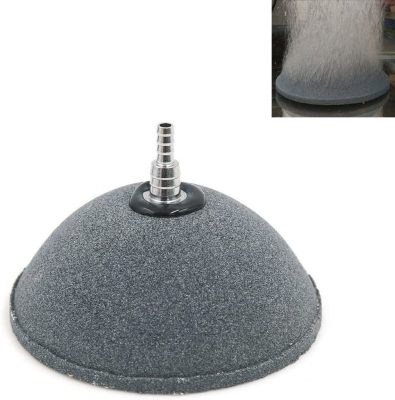
Editor’s Rating:
Why we like it: The Pawfly 4 Inch offers an incredibly jetting volume that can't be matched in terms of water agitation or bubble production.
Quick Facts
- Size(s): 4” x 1.5”
- Fits tubing diameter of: 3/16″ or ⅜”
- Pump power required: 4W+
- Jetting volume: 20L /min
- Includes: 1 air stone
Sizing & Power
VIVOSUN is the only other top 10 stone to require such a powerful pump (4W+), perhaps unsurprising as both are designed specifically to add oxygen and lower CO2 in larger hydroponic aquariums and planted tanks.
While we feel that the VIVOSUN is a better all-round offering, if your end goal is a high jetting volume, this is where to spend your money; it’s unrivaled at 20L/m.
Style & Bubble Effect
The Pawfly 4 Inch looks like the top half of a tennis ball with a connector placed vertically through the top. Nothing fancy, but you’ll probably be too mesmerized by the epic bubble production to notice.
Notably, this air stone requires a lengthy pre-soak for maximal bubble production, longer than for any other stone we’ve seen. 3 hours is the recommended soak time given by Pawfly, but we suggest you give it 6. At full production, the bubble rate is a strong stream of fine, dense bubbles.
Materials & Durability
The top vertical inlet connector means it can sit perfectly flat and stable on the base of your tank. Plus, the connector tip is metal, unique amongst products we’ve reviewed. This makes the connector much more durable, but we find that initially, it makes connecting the tubing attachments a little harder.
Pros
- Epic high-powered jetting volume
- Base stays solid in substrate
- Long-lasting, metal tubing connector tip
Cons
- Requires a lengthy presoak
- Difficult to attach tubing to metal tip
- Only suitable for strong air pumps
8. Best Multi-Tank Air Stones: Wenshall 1.6" Small Round Air Stones
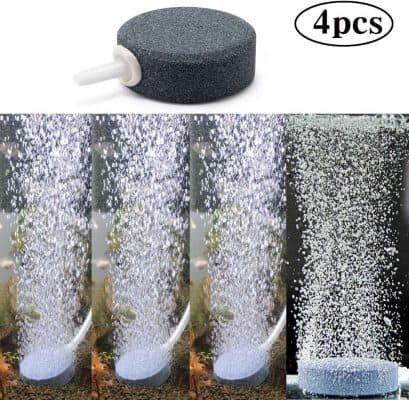
Editor’s Rating:
Why we like it: This compact set of air stones is perfect for multi-tank use, thanks to the handy inclusion of multiple T-connector splitters.
Quick Facts
- Size(s): 1.6” x 0.6” x 0.6”
- Fits internal tubing diameter of: 3/16”
- Pump power required: 2W+
- Jetting volume: 2L/m
- Includes: 4 air stones, 2 three-way splitters
Sizing & Power
The inclusion of 2 three-way splitters means you can power all the included air stones from one air pump. In other words, buy these stones and you can aerate four separate tanks simultaneously – very impressive. This makes Wenshall air stones an obvious choice for aquarists with a multi-tank setup, who don’t want to face the financial outlay of buying additional pumps.
Style & Bubble Effect
We consider these ‘cake-shaped’ stones a hybrid design of the various Pawfly cylinders and the larger, disk-shaped Hygger Air Stone. It’s a nice middle ground – heavier and more stable than the former, yet smaller than the latter.
They produce a surprisingly strong bubble rate for their size, too. Unfortunately, they’re loud. Much louder than anything else on our list, in fact. We see these stones as best suited for a multi-tank owner who uses a basement or garage space for their aquariums, rather than those who keep their setup in a main living space.
Materials & Durability
Unfortunately, the level of bubble production appears to vary between stones in a somewhat random way. Our best explanation for this is an inconsistency in the material density. The inconsistency shouldn’t be severe enough to render any stone useless, but there’s little you can do when the air stones are being powered through the same air pump – far from ideal.
Pros
- Only a single pump required to run 4 air stones
- Unique 'cake' design
- Excellent bubble production for the size
Cons
- Loud
- Bubble variance between the stones
9. Best LED Air Stone: NICREW Multi-Colored LED Air Stone Disk

Editor’s Rating:
Why we like it: Hands down, this is the best LED air stone on the market. This device emits 6 changing colors to create a dazzling visual ambiance in your aquarium.
Quick Facts
- Size(s): 2″ and 4″ diameter choices
- Fits internal tubing diameter of: 3/16″
- Pump power required: 3W+
- Jetting volume: not specified (low)
- Includes: 1 air stone, suction cup, tubing, power adaptor
Sizing & Power
We like the choice in sizes, but even the bigger stone has a rather weak flow rate. But don’t write this off as a gimmick product – it does offer enough airflow to satisfy the average hobbyist, it just won’t blow your socks off.
Style & Bubble Effect
The bubble production is below average but the lighting effects largely make up for this. An LED base emits 6 colors that change automatically, giving a dazzling underwater light show. It looks incredible in dark rooms and adds a whole new feel to your aquarium after nightfall.
Materials & Durability
The air stone itself is well made and the built-in suction cup mount ensures it won’t be displaced easily. Plus, this stone comes with air tubing, something that only the Pawfly All-in-One Kit and the NICREW Aquarium Volcano can also offer. Still, as the tubing is connected to the bottom of the stone and the stone is designed to sit on the substrate, it can bend and weaken over time.
Unfortunately, the power cord is only 5ft long, and tanks with >10-gallon volume will probably need to run an extension cord. Plus, there’s no on/off switch for the LED lights. It’s unlikely you’ll want them to run all day and so you’ll need to switch them off directly at the outlet. Thankfully, this doesn’t impact the bubble production.
Pros
- Dazzling visual display
- High-quality LED lights
- Includes connector tubing
Cons
- Short power cord
- No on/off switch for LED lighting
- Tubing may bend due to underside position
10. Best Novelty Air Stone: NICREW Aquarium Volcano
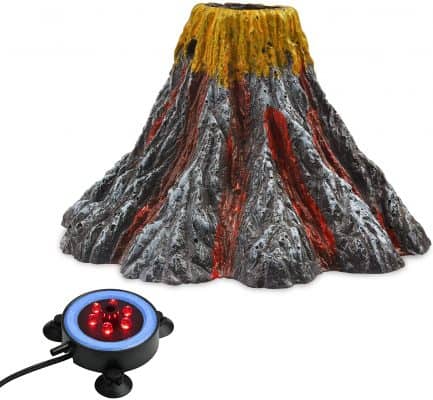
Editor’s Rating:
Why we like it: A unique design that will add flair to any tank. Hotter than lava but still cool enough for your aquarium.
Quick Facts
- Size: 4” x 6”
- Fits internal tubing diameter of: 3/16″
- Pump power required: <2W
- Jetting volume: not specified (low)
- Includes: 1 air stone, volcano exterior, suction cup, tubing, and power adaptor
Sizing & Power
The Nicrew volcano is the only device we reviewed that requires a pump or 2W or under, and this is reflected by its underwhelming bubble production. As the base of the volcano measures just under 6″, we suggest you have at least 7.5″ of free substrate space, or it’ll look cramped. If that’s too much, you may prefer the TEEMO Groot – another decorative stone of a similar height, but that takes up much less space in the substrate.
Style & Bubble Effect
The standard option comes with a singular red-colored LED light to match the unique volcano theme. But if you’d prefer to match the volcanic exterior with the changing color show seen in the NICREW Multi-Colored LED disk, you can spend a little more and buy these together.
PRO-TIP: Place this volcano at the back of your aquarium for the best visual effect. As the volcano is tall and the area above it is distorted by bubbles, placing it close to the front of your tank will cut off a significant amount of viewing space.
Materials & Durability
We like that the air stone isn’t fixed to the ornamental structure. As your aquarium evolves you may wish to change your air stone style, and the fact that they’re not glued together means you could remove the air stone and keep the volcano as a purely decorative piece, or place another stone under the structure. Plus, there’s a small cut-out in the volcano structure that allows the wiring to run through. As the volcano doesn’t sit directly atop the cables, you don’t need to worry about instability when nestled on the substrate, or the wire getting damaged over time.
It also comes with airline tubing, which is a nice touch. Unfortunately, there are no setup instructions and the three suction pads on the base are a little weak. You’ll find yourself having to reattach them occasionally – an inconvenience you don’t need to deal with on heavier devices.
Pros
- Great novelty choice for a unique look
- Volcano and air stone can be separated
- Cut out for wiring allows for stable positioning
Cons
- Air stone performance below average
- Weak suction pads
- No setup instructions
Guide to Buying the Best Aquarium Air Stones
All the air stones to feature in our review list help create water agitation and lead to healthier fish and aquatic plants. But how do they work exactly? Let’s kick off our guide with some insight into aquarium oxygen levels and the benefits of air stones.
Are Your Fish Getting Enough Air?
A reduction in swimming activity, rapid gill movement, loss of appetite, and gasping near the waterline are all signs of oxygen deprivation in fish – a big killer of both freshwater and saltwater fish. Here are the three most common causes.
- An overstocked tank
- A water temperature that’s too high
- Insufficient water agitation
While the first two can be easily remedied with appropriate care and planning, water agitation is a little more tricky. Enter the air stone – a cheap, simple way to boost your aquarium’s oxygen.
How Aquarium Air Stones Work
When connected to a pump, an air stone produces a fine stream of bubbles. An air stone isn’t required to create bubbles – simply running an air pump that’s connected to an open airline will also do this. The problem is these bubbles are large and loud and will cause disruption to your fish. Attaching an air stone to the pump gives a much finer bubble stream and removes the majority of this noise.
Notably, it’s not actually the bubbles themselves that add oxygen to the water, although this is a common misconception. Instead, the bubbles create surface agitation that leads to a gas exchange – swapping the carbon dioxide in the water for oxygen in the air.
Do You Need an Air Stone?
If you use a filter for circulation, then an air stone isn’t always necessary, but it’s always beneficial.
An air stone is absolutely essential for the well-being of your aquarium if it’s the only method of circulation in your tank, as stagnant water has very little oxygen. Otherwise, the need for an air stone will depend on your tank’s oxygen levels. Each of the below circumstances makes it more likely that you’ll benefit from additional oxygen.
- Lower water surface area (i.e., a tall, narrow tank)
- A low-powered filter
- An overstocked tank
- A heavily planted aquarium
You can monitor your fish for symptoms of oxygen deprivation, or test the amount of dissolved oxygen in your aquarium’s water by buying a dissolved oxygen meter. But for most folks, it’s simply more convenient to buy an air stone, as they also offer several additional benefits.
Benefits of Aquarium Air Stones
Here are the benefits you can expect to enjoy when using an aquarium air stone.
Improved Aeration
Using bubbles to circulate water and create surface agitation means that more surface water is exposed to air, where there’s a gas exchange of carbon dioxide (leaving the water) and oxygen (entering the water).
Better Filtration
With improved water circulation, loose waste and debris is moved around the tank. This makes it more likely to be picked up by your filtration system – leaving you with a cleaner tank, and healthier fish and plants.
Quiet Water Agitation
Adding a stone to airline tubing makes the water agitation much quieter, important for those who keep aquariums in their home and as to not disturb fish.
Fixing Dead Spots
Some aquariums suffer from ‘dead spots’, essentially a small zone of stagnant water that’s prone to a buildup of dirt and debris. Placing an air stone in the dead spot can instantly fix this issue.
A Stunning Aquascape
A stream of fine bubbles makes a beautiful backdrop to any aquarium and many aquarists use an air stone for the visual impact alone.
Picking the Best Air Stone for Your Aquarium
If you still can’t decide which of our top 10 air stones is best for your aquarium, we suggest that you prioritize functions that suit the type of aquarist you identify as. Here are the most common.
Beginner Aquarists
If this is your first experience of air pumps and stones and you want to stick to the basics, we recommend that you opt for one of the ‘all-in-one’ kits – they take the guesswork out of tubing/power sizes and you won’t risk any compatibility issues.
Recommendation: Pawfly All-in-One Kit or Hygger Air Stone
Aquascapers
If your primary focus is housing an aquarium that turns heads, you don’t want to cut corners. You’ll need a stone that blends in well with your substrate, and disk-shaped stones are our favorite pick for this purpose. Alternatively, if your aquarium is kept in a primary living space and/or used as a decorative showpiece, an air stone with LED lighting is just what you need to give your tank that extra pop, after sundown.
Recommendation: Hygger Air Stone or NICREW Multi-Colored LED disk
Nanotanks Owners
If you’re the proud owner of a nanotank (<10-gallon volume) then you want a low-powered air stone. Anything above 2W is likely to disrupt your fish, create excessive water circulation, and draw attention away from the rest of your tank. The best-looking air stones subtly complement your aquarium but aren’t the focal point.
Recommendation: TEEMO Groot Air Bubbler or NICREW Aquarium Volcano
Large & Planted Aquarium Owners
Conversely, if you own a sizable tank and/or have lots of live plants, you’ll need an air stone (and pump) to match and should only consider stones that need a pump power >4W. A strong bubble flow and high jetting volume are the most important factors here.
Recommendation: Like the VIVOSUN Air Stone or Pawfly 4 Inch Air Stone
Multi-Tank Owners
With a multi-tank setup, you may wish to run multiple stones from a single air pump, as it’s cheaper and more energy-efficient than buying multiple. If so, you’ll need to branch your airline tubing using T-connectors, so a product that includes these will save you an additional purchase. If you anticipate using multiple air stones, but don’t yet own a pump – make sure to choose a dual-out air pump, which will effectively double the number of stones you can use with one pump.
Recommendation: Pawfly All-in-One Kit or Wenshall 1.6″
PRO-TIP: Air stones operate 24/7. While large stones are great for their aeration and visual output, there’ll usually be a trade-off in noise, as they require a higher-powered pump to function. Bear this in mind if you own a tank that’s kept in a living space or bedroom. Everything sounds twice as loud when you’re trying to sleep!
Equipment You Need to Get Started
Each product on our review list comes with different accessories. Now you’ve got your heart set on the perfect stone, use our equipment checklist to make sure you’ve also got all the other gear you’ll need.
Essential Equipment
- Air pump: an outlet-powered air supply
- Air stone: porous material that disperses a fine bubble flow
- Airline tubing: soft tubing to connect your air stone to the pump
- Air control valve: manually controls airflow (often sold with air pump)
Optional Extras
- Check valve: placed in the tubing to prevent backflow of water
- T-connector: used to branch tubing and power multiple stones from one pump
How to Set up an Aquarium Air Stone
Now you’ve picked your stone and have all the equipment you need, all that’s left is to set it up! Here’s how it’s done.
- Soak your air stone according to manufacturer instructions, typically between 1-3 hours
- Attach one end of the airline tubing to the pump outlet
- Use scissors to make a cut in the tubing (around 5″ from where it connects to the pump)
- Fix the control valve between the cut tubing ends
- Optional: make a second cut to attach the check valve
- Attach your air stone to the open end of the airline tubing
- Use suction cups to attach the air stone to the aquarium glass, or nestle it firmly within the substrate
Where to Place Air Stones in Your Aquarium
Ok, so now you’ve found the perfect air stone and know exactly how to get it up and running. But before you get started, there are some locations you should know to steer clear of. For long-term success, here are three tips for placing your air stone.
- Away from the filter: You need the bubble flow to reach the water surface where the gas exchange takes place and a nearby filter can disrupt this process and reduce surface agitation
- Amongst natural growth: Placing your air stones amongst plants can help disguise the stone with your tank, helping to maintain a more natural aquascape
- Avoid hiding spots: Stay away from the natural hiding places of shy fish to avoid causing unnecessary stress
How to Clean & Maintain Your Aquarium Air Stones
Once you notice that your air stone’s bubble production has reduced, they’ve become larger, or the porous material looks dirty – it’s time to clean. Here’s our 12 step process for how it’s done.
- Turn off your air pump (trust us, you’ll only forget this step once)
- Detach the airline tubing and remove the air stone from your aquarium
- Place your air stone in a bowl or drinking glass
- Make a simple DIY bleach solution: we prefer a 9:1 ratio of water to bleach
- Add this solution to the bowl/glass until the stone is fully submerged
- Leave it to soak for ~3 hours
- Remove the air stone and discard the cleaning solution
- Use a soft-bristled toothbrush to gently scrub the stone in a circular motion
- Thoroughly rinse the stone under cold running water to remove any loose debris
- Leave the air stone to fully dry (~3 hours)
- Re-attach the tubing and air pump and return the stone to your tank
- Switch your pump back on and enjoy the bubble show
How often you’ll need to follow this process is largely dependent upon the size and quality of your air stone, but monthly is a good starting point. Once you find that the cleaning process isn’t sufficient to return your air stone back to its former glory, it’s time for a replacement.
Frequently Asked Questions
Is an Air Stone Suitable for a Saltwater Aquarium?
Yes, air stones are routinely used in both freshwater (tropical) and saltwater aquariums. However, you should be careful when using an air stone in a saltwater aquarium, due to salt creep. Salt creep is where water splashes out of the tank, and once the fresh water evaporates you are left with unsightly salt crystal stains. To avoid this, make sure you choose an air stone and air pump suitably powered for the size of your tank.
Can an Air Stone Add Too Much Oxygen to My Aquarium?
Technically yes, an air stone can contribute to excess oxygen in an aquarium. But this is a highly unlikely occurrence and will not be caused by an air stone alone. Usually dangerous levels of oxygen are caused by leaking pipes or rapid water heating and can result in the potentially lethal, gas bubble disease. If you are concerned about excess oxygenation, you may wish to purchase a dissolved oxygen meter.
Why Isn’t My Air Stone Working?
If you have a new air stone, the most common reason for it not working is pump incompatibility. Check that your air pump is powerful enough for the air stone to operate and that the tubing used is correctly sized according to the manufacturer’s recommendations.
If your air stone has suddenly stopped working, this is typically a result of algae build-up. To solve this, follow our guide on how to clean and maintain your aquarium air stone. If this doesn’t work, ensure that your check valve is positioned correctly and that there are no kinks in the tubing. If that doesn’t solve your issue, detach the stone and make sure the air pump still works when used with open airline tubing. If it does, it’s time to buy a new air stone.
A Health Investment for Your Aquarium
If you were under the illusion that air stones were little more than gimmicky bubble machines, our guide should have helped show you the air-er of your ways. Sorry, we couldn’t help it.
Improved circulation, more effective filtration, and increased aeration. Plus, they look great. What’s not to love?! If you’ve been starting to question whether your fish could do with an oxygen boost, it’s time to take the plunge and test out an air stone for yourself. Whether you favor the unmissable dazzle of LED lights or prefer to keep things low key with the small 1″ cylinders, you’re investing in the health of your fish and plants and will reap the rewards over the long-term.
